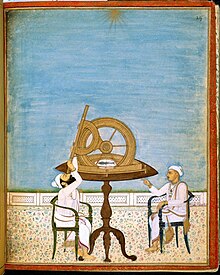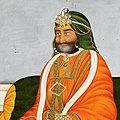Lehna Singh Majithia
Sardar Lehna Singh Majithia | |
|---|---|
 Portrait of Sardar Lehna Singh Majithia, ca.1830 | |
| Died | 1854 Banaras (modern-day Varanasi) |
| Known for | Sikh polymath: scientist, inventor, architect, engineer, mechanic, writer, warrior, and statesman |
| Title | Administrator (Nazim) of Amritsar Governor (Nazim) of Kangra and Hill Districts |
| Children | Dyal Singh Majithia |
| Parent | Desa Singh Majithia (father) |
| Relatives | Gujar Singh (brother) Ranjodh Singh Majithia (younger half-brother) |
| Family | Majithia |
| Honours | Kasir-ul-Iktidar (Chief of Exalted Dignity) Hasam-ud-Aula (the Sword of the State) |
Lehna Singh Majithia (died 1854), also romanized as Lahina or Lahna, was a polymath, inventor, warrior, and statesman.[1][2] He had an interest in statecraft, architecture, mathematics, astronomy, firearms, mechanics, languages, art, and ordnance.[3] Lehna Singh was the father of famous businessman and philanthropist, Dyal Singh Majithia.
Biography
Family background
Sardar Lehna Singh of the renowned Majithia family was the towering Sardar of Lahore Darbar who earned the maximum number of bravery titles during his time. Lehna was the son of Desa Singh Majithia, a feudal chief whom had sworn allegiance to Ranjit Singh in 1809, later serving in the military expedition to Kangra, which pushed the Gurkhas out of the Punjab Hills region.[3] Thus, Desa was promoted to position of the governor of Kangra and the city of Amritsar.[3] In 1818, Desa served in the Multan campaign.[3] Lehna was the eldest son of Desa.[3]
Service in the Sikh Empire

With the death of his father in 1832, Lehna inherited his father's administrative positions as governor of Kangra and the city of Amritsar.[3] As the governor of the city of Amritsar, Lehna had purview over the governance of the Golden Temple in Amritsar, Sikhism's central shrine.[3] During the governance of Lehna, the Golden Temple underwent renovations, such as the laying of marble slabs around the inner parkarma (temple causeway) of the temple complex, with gardens being established elsewhere in the holy city.[3]
He was described as "the wisest man", "the best", "the purest", "the most cultured", "kind and benevolent man", "the most enlightened", "the most honest and able administrator of the Sikh Chiefs". In his book "Dyal Singh Majithia: Life and Achievements", Mr. Madan Gopal wrote, "Lehna Singh Majithia was the only Sardar with a scientific bent of mind at Maharaja Ranjit Singh's Darbar."[4] Skilled in language-learning, it is purported that Lehna had translated works of Euclid into Punjabi.[3] Lehna assisted general Claude Auguste Court on constructing cannons based on European models.[3]
He was also a skillful mechanic and inventor. He designed a mechanism resembling a clock, showing the hour, the date, the day of the week and the phases of moon and other constellations. At the request of the Maharaja, he also modified the calendar and made a name for himself among the Indian astronomers of the time.[5]
He had been awarded the titles of Kasir-ul-Iktidar ('Chief of Exalted Dignity') and Hasam-udaula ('the Sword of the State') by Ranjit Singh.[6]
Later life
He left Punjab in March 1844 for Haridwar, eventually settling in Banaras. He was arrested and kept under surveillance by the British from 23 January 1846 until the end of the First Anglo-Sikh War. He returned to Punjab in 1851 and stayed for two years before returning again to Banaras where he died in 1854.[7]
Inventions

- Compass[8]
- Sikh calendar[8]
- Sikh firearms (notably pistols)[8]
- Sikh cannons, some of which were renowned as being technologically superior to the cannons the Britishers possessed[8]
- Clock-like mechanism that showed hour, weekday, date, time, moon phase, and constellations. It was called the Dhup Ghari (meaning 'sun clock')[9]
Construction projects
- Supervised the redecoration of the Golden Temple and the reconstruction of Amritsar during Sikh-rule[9][8]
- Assisted with the construction of the Summer Palace of Ranjit Singh (known as Ram Bagh)[8]
- A garden that spread over 84-acres surrounded by a high wall and a moat. It contained rare plant species[8]
Gallery
- Sardar Lehna Singh Majithia (Water Colour c.1830 V & A Museum)
- Sardar Lehna Singh Majithia, by Hasan al-Din, Lahore, Punjab, ca.1845–50
- Lehna Singh Majithia, ca.1865 depiction
References
- ^ Singh, T. Sher. "This Needs Research - V: Who Was Lehna Singh Majithia?". www.sikhchic.com. Retrieved 12 September 2022.
- ^ "Desa Singh Majithia". The Sikh Encyclopedia. 19 December 2000. Retrieved 13 September 2022.
Desa Singh died in 1832, and was succeeded in all his estates and honours by his eldest son, Lahina Singh Majithia.
- ^ a b c d e f g h i j "Lot 196: The Sikh polymath, inventor, soldier and statesman, Lehna Singh Majithia (d. 1854), riding past a walled city, possibly Lahore, besides a flowing river". Bonhams. 12 November 2024. Retrieved 24 November 2024.
- ^ Gopal, Madan (9 September 1998). "A Broad-Minded Liberal". www.tribuneindia.com. Retrieved 12 September 2022.
- ^ "Sardar Lehna Singh Majithia: The purest gem of Maharaja Ranjit Singh's court, Varinder Walia", The Tribune.
- ^ Griffin, Lepel Henry (1890). The Panjab Chiefs: Historical and Biographical Notices of the Principal Families in the Lahore and Rawalpindi Divisions of the Panjab. Civil and Military Gazette Press. pp. 269–270.
- ^ "Lahina Singh Majithia". The Sikh Encyclopedia. 19 December 2000. Retrieved 13 September 2022.
- ^ a b c d e f g Walia, Varinder (15 September 2005). "A Golden Leaf From the Annals of Sikh History - Sardar Lehna Singh Majithia: The purest gem of Maharaja Ranjit Singh's court". AmritsarPlus Online Edition - The Tribune India (www.tribuneindia.com). Chandigarh, India. Retrieved 12 September 2022.
- ^ a b Walia, Varinder (8 September 2005). "Special on the death anniversary of Sardar Dyal Singh Majithia, which falls on September 9 - Majithia's virasat knows no sarhad". The Tribune India.
His father, Sardar Lehna Singh, a great engineer of his time, was a pious person who had installed "Dhup Ghari" (sun clock) and contributed in the extension of Darbar Sahib with his great engineering skills.
External links
Further reading
- Singh, Khushwant (1984). A History of the Sikhs.



